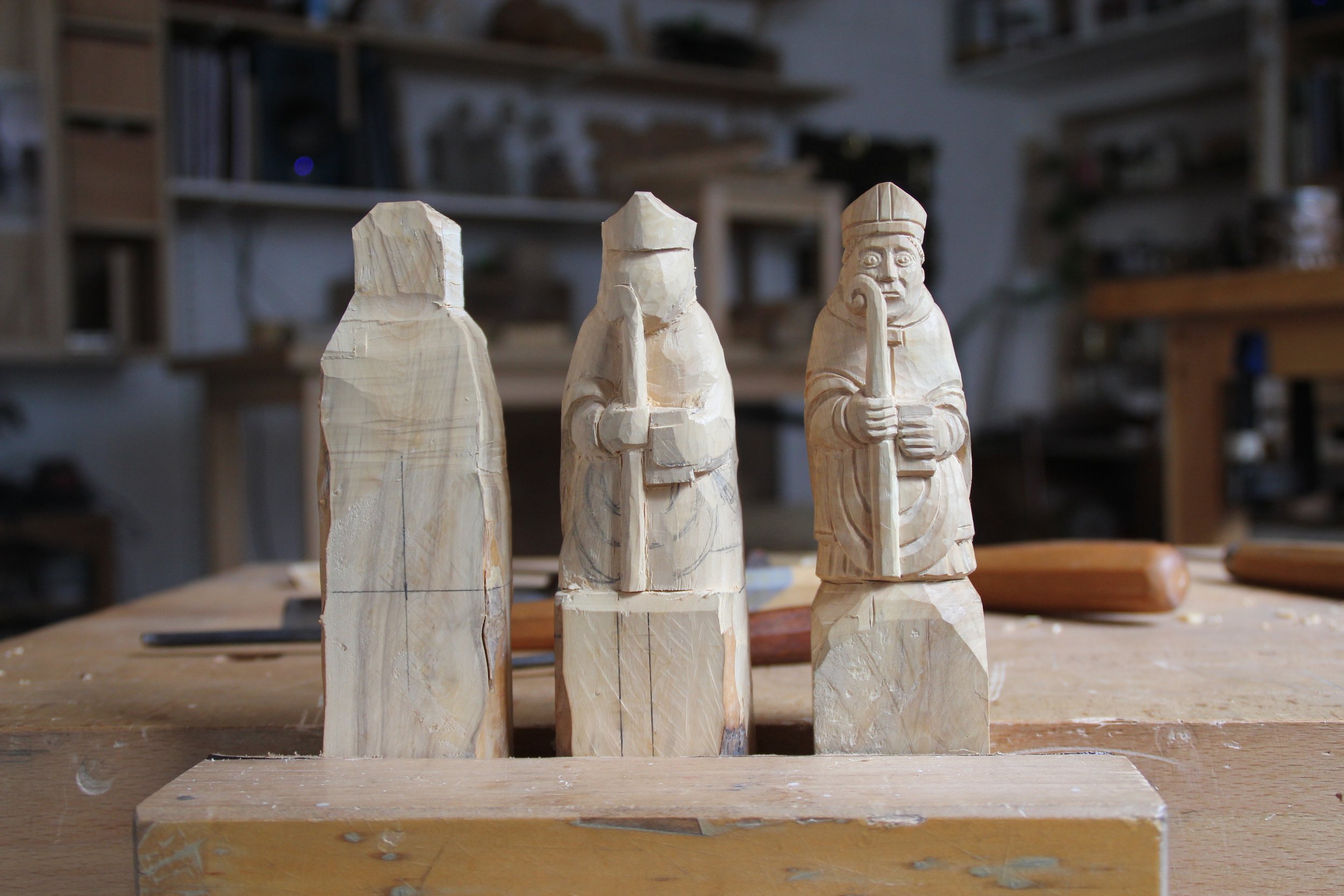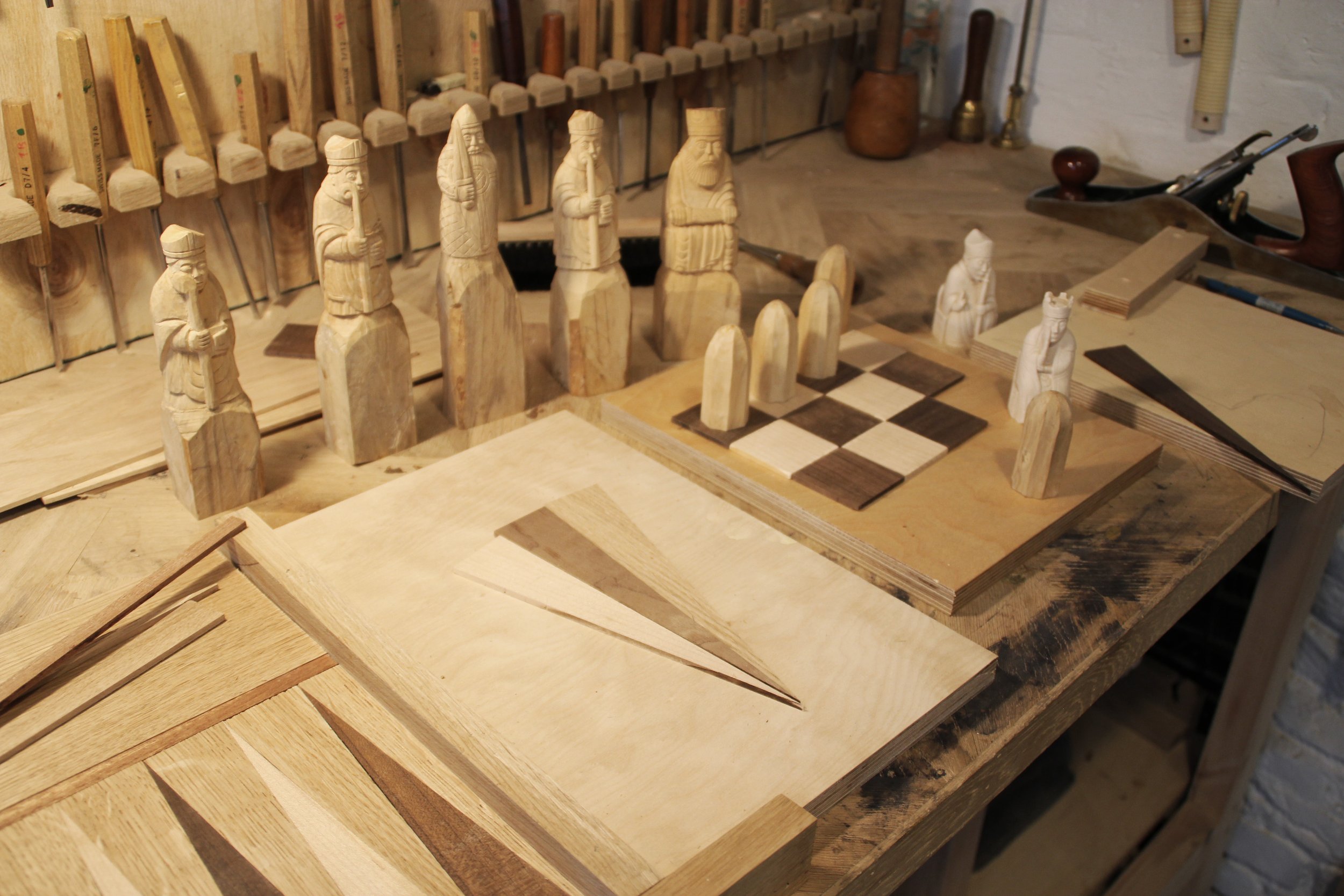The making of the Lewis Chess Set and Backgammon Table
Wood Carving London were recently commissioned by a private client to recreate a bespoke Lewis Chessmen and backgammon set using Box wood taken from clients garden. The table now lives in a newly built garden room designed by renowned architect Ptolemy Dean on the grounds of the clients country house after extensive landscaping carried out by Tom Stuart Smith
This unique set of stools and table, made from air-dried French oak, combines practical design with skilled craftsmanship. The table and stools are joined using wedged through-tenons while the drawers are constructed with hand-cut dovetails for added durability. The table features two reversible game boards—chess on one side and backgammon on the other—crafted from a mix of quality hardwoods including sapele, American black walnut, maple, oak, and red oak. The chess pieces, no taller than 9 cm, are inspired by the famous Lewis Chessmen and are carefully hand-carved from boxwood taken from the client’s garden. The backgammon pieces are turned from the same wood and feature simple, carved concentric circles. The drawers have individual housing for each chess piece as well as a removable tray for the backgammon pieces and a separate section for housing the dice cup.
About the Lewis Chessmen
The famous Lewis Chessmen were found on the Scottish isle of in the early 19th century, are carved in Walrus ivory and sperm whale tooth and date back to 12th or early 13th century in Norway. The hoard contained 93 gaming pieces in total, including from at least four chess sets as well as other games, and the medieval chess pieces now reside in both The National Museum of Scotland and The British Museum.
Click here to see a 3D rendering of the original pieces.
Project Brief
We were asked to design and build a ‘chunky outdoor’ table and stool set which incorporated both chess and backgammon boards. Inspired by a table the family had used whilst holidaying abroad, the finished piece would live outside in the pool house and must have drawers to house all the pieces and dice cups. The functionality was key and the game boards needed to be quickly accessible and interchangeable. The clients boxwood must be incorporated as much as possible.
“The box wood is how this whole project came about”, Clemy says. “Working with the garden designer Tom Stuart Smith we sadly had to remove several mature box trees, but so as not to go to waste the wood was kept for a special project. As our family love playing chess and backgammon, I searched for a while to find some wood carvers to create a set, and finally came across Jim and Tom. Whilst discussing the commission we found we were admirers of the Lewis Chess Set and decided with their skills that this would be the most creative use of the wood. ”
Creating the table
We began by making drawings of the chess pieces, considering what scale would be possible with the tools and the material. We also wanted to add a height gradient from the king and queen to the rook, something that the original set doesn’t have. The size of our pieces dictated the size of the board, which in turn dictated the structure of the table.
We used French air-dried oak (from English Woodland Timber) to construct the furniture as the slow seasoning process is ideal for outdoor use, where the moisture content in the air changes throughout the year. For joints, we chose heavy wedged through-tenons, which helped the ‘chunky’ feel of the piece and added square details to the top surfaces, mimicking the squares of the chessboard.
The reversible board had to be inlaid for durability outside, and we experimented with various naturally colored hardwoods to celebrate the purity of the material. Tom was able to build a jig with which to cut the elongated triangles that make up a backgammon board and some of the boxwood we were able to turn into dowel before cutting into discs.
The drawers had to accommodate all of the pieces from both games, and a cylindrical cup for dice - it was a snug fit. We decided early on that the back row of chess pieces needed to lay in formation, and fabric cushioning was even discussed before we once again reverted to purity of material and carving custom inserts. Each has its own inlaid square of boxwood delineating colour to avoid any confusion.
Carving the chess pieces was a labor of love. Processing the boxwood from irregular logs into square section lengths meant that we could produce several duplicates in a single length, removing as much material with the saw before picking up the chisels. The duplication also allowed us to take more liberties with the characters’ expressions, adding sideways glances and even a drooping horse tongue. The pieces although formulaic in their modelling, are each completely unique and hold a real sense of personality.
“It has been such a pleasure to see the pieces being made and I have loved visiting their wonderful studio in Kennington, being distracted by all their other fascinating projects. We are thrilled with the end result of this exceptionally well thought out games table, and the exquisitely carved chess and backgammon pieces, that I hope our family can enjoy for generations.”















